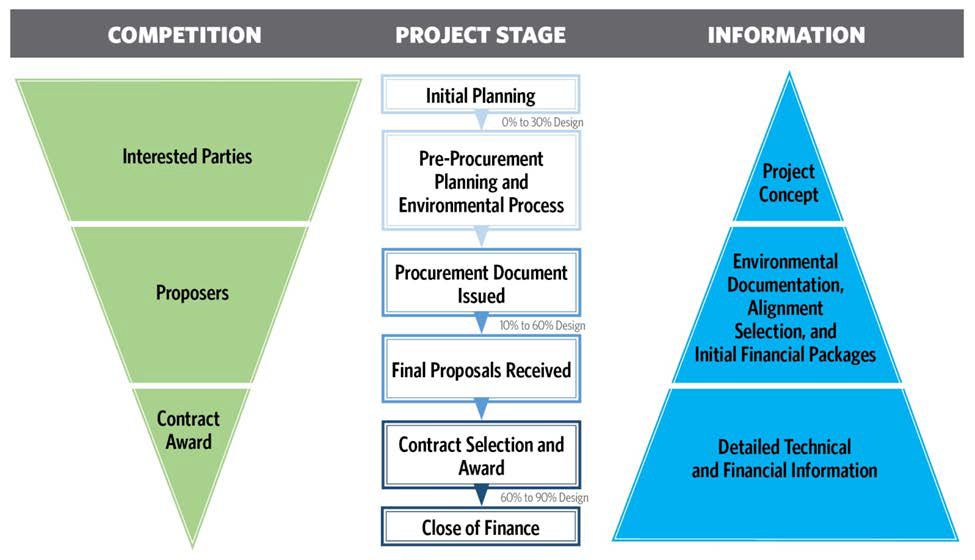A key objective of the Fixing America's Surface Transportation Act (FAST Act), signed into law on December 4, 2015, and its predecessor, Moving Ahead for Progress in the 21st Century Act (MAP-21), is to support and assist public agencies in working with the private sector in delivery of transportation facilities. Consistent with this objective, this report draws upon past and current experience to examine different mechanisms used by public agencies for involving private developers during the early stages of a project delivered through a public-private partnership (P3). The report is structured in accordance with the three major stages in the project planning and development process - planning, procurement, and post- procurement - during which private parties may participate in and/or comment on a given project to improve its financial and technical feasibility and achieve other public sector objectives, as shown in the figure below (Figure 1-1). The report also evaluates the political, legal, regulatory, competitive, financial, and technical barriers to the early involvement of the private sector.
Figure 1-1. Private Sector Feedback and Involvement Mechanisms by Project Stage

Flow chart: Mechanisms Used During Project Planning » Mechanisms Used During Project Procurement » Mechanisms Used During Post-Procurement
Public Agency Objectives:
The research effort relied on a literature review, interviews with P3 practitioners, and a review by a roundtable of P3 experts to identify the consultative and feedback mechanisms used during project planning and procurement. The study also evaluated the consultative mechanisms used during project procurement and after contract award and considered introducing these types of activities earlier in the project development process to encourage private sector input. This evaluation has been used to identify approaches that have been effective and to provide suggestions for securing early input from the private sector to enhance opportunities for public-private partnerships.
The objective of this report is to identify existing and potential approaches and evaluate the lessons learned regarding the early involvement of the private sector in P3 projects. While the emphasis is on long-term concessions such as Design-Build-Finance-Operate-Maintain (DBFOM) contracts, selected approaches for early involvement of the private sector in Design-Build contracts have been included, where applicable, in terms of lessons learned.
As shown by Figure 1-2, the research objective requires consideration of the appropriate balance between encouraging competition (and its associated creative tension) and facilitating information flow. This report builds upon previous research studies by providing an overview of the experiences of state departments of transportation (DOTs), local agencies, private developers, and financial institutions in soliciting potential innovations from private companies during planning and procurement. The report consists of two major elements: (1) a literature review that describes national and international experiences with the solicitation of private-sector feedback during the early phases of a P3 project; and (2) interviews with P3 practitioners. Interviewees consisted of current and former P3 program managers from state DOTs and local governments and P3 experts from legal, technical, and financial advisory firms. Interviewees were contacted by phone, in person, and via email. Initial findings were presented to a roundtable of P3 experts on May 21, 2016. Feedback from roundtable participants was incorporated into this report.
Figure 1-2. Competition versus Exchange of Information

| Competition | Project Stage | Information |
|---|---|---|
| Interested Parties ↓ |
Initial Planning (0-30% Design) ↓ |
Project Concept |
| Pre-Procurement Planning and
Environmental Process ↓ |
||
|
Proposers ↓ |
Procurement Document Issued (10%-60%
Design) ↓ |
↑ Environmental Documentation, Alignment Selection, and Initial Financial Packages |
| Final Proposals Received ↓ |
||
| Contract Award | Contract Selection and Award
(60% to 90% Design) ↓ |
↑ Detailed Technical and Financial Information |
| Close of Finance |
Previous research reports have focused on identifying barriers to P3 project development and on approaches to attract and increase the level of investment in P3 projects generally. However, there is limited research evaluating specific techniques that can encourage early involvement of the private sector to enhance opportunities for innovation during P3 project development. Listed below are 11 key reports reviewed, with findings from each summarized in Appendix B.